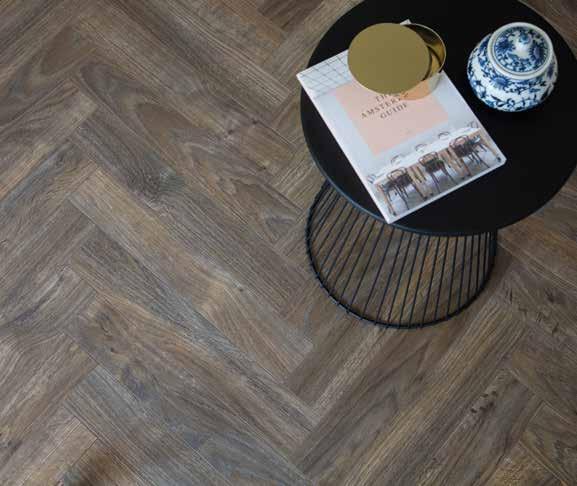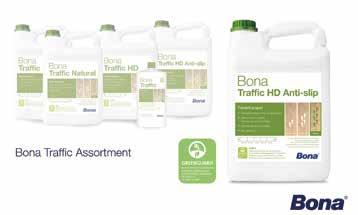Special
Anti-slip finish for in and outdoor wooden floors
‘ANTI-SLIP PREVENTS SLIPPING’ IDEAL FINISHES HAVE TO MEET LOTS OF CONDITIONS People sometimes forget that although wooden floors can look so charming, you certainly don’t want to slip over on them and break your neck. And so, in this article we consider the best approach to anti-slip treatment for both indoor and outdoor floors. We also consider the relevant European legislation.
Anti-slip or smooth? What standards does an anti-slip floor have to meet? In that connection, you also have to define primarily what anti-slip means. After all, there is a difference between anti-slip and smooth (or slippery). Anti-slip is defined as follows: suitable for stopping people (or apparatus) from sliding on it. By contrast, a smooth or slippery surface is easy to slip on. And so, a terrace or parquet floor is anti-slip if it prevents slipping by stopping the slipping motion itself, whilst we speak of smooth if the floor helps to prevent slipping. And so, finishes, sealants, or oils used on wood can be subdivided into anti-slip (with a European standard to show their performances) or smooth. This rule applies to indoor parquet floors, but not to terraces because terraces are exposed to two extra pressures apart from the weight of footsteps. Those extra pressures are bad weather (with the accompanying presence of water or snow) and ultraviolet rays, and that’s to say nothing about fluctuations in temperature.
Do residential applications differ from commercial ones?
You yourself probably wonder if there is a difference between residential and commercial applications. The clear answer is that there is no difference. It goes without saying that in both domestic homes and commercial rooms you need a floor on which you will not slip. Obviously, it’s always possible to ask a professional to apply an antislip finish, but in that case users have to accept the limitations. This means there is little choice as regards outward appearance (gloss, matt, colours, etc.) and with sports floors there are also inherent related maintenance limitations. The difference is defined. Slipping can have unfortunate effects, mainly in a sports context, but also in some medical or paramedic institutions (e.g. nursing homes, crèches, or homes for the disabled).
Composition of finishes Before the fitting, you need to consider what is ideal in terms of anti-slip for indoor and outdoor use respectively. You can assume initially that a wooden terrace is naturally anti-slip provided it is dry. It is well known that wet wooden floors are slippery, and manufacturers offer various solutions to deal with that. For instance, planks are supplied with a deeply grooved surface which provides a perfectly ‘natural’ anti-slip surface whenever it is fitted on the outside.
Be careful with terraces Saturators are the only possible form of protection for terraces. The anti-slip seal largely owes its effect to micro-fillings (hard mineral or organic particles with a precise grain size inside the seal), but it is not yet possible to develop a saturation agent based on the same principle, and that is due to the same technical reasons as for oil for indoor floors. A sprinkling of calibrated micro-particles would no longer have any effect because saturators basically protect the wood by impregnation. Fitting anti-slip strips is the only reasonable option, and that strongly resembles the original grooves. We would also point out that using a stain contravenes the very principle of durable protection of a horizontal wooden structure fitted in the open air. This is a technical error since a stain should never be fitted to a wooden floor in the open air. Moreover, there is also the obligation to repeat the operation to compensate for the regular and rapid removal of micro-particles under the effects of footsteps. The thickness of the film marks will increase and that means it is more likely to peel off! Source: Blanchon.
Some specialists Blanchon For interior parquet Blanchon recommends its SPORT® range. This consists of glazers and ‘paints’ for applying lines and covering surfaces. New in this range is Sport Solid, which consists of polyurethane with a highly fluid consistency, high filling capacity, excellent performances, and rapid setting. It has been designed specially for sports floors and the uniform exterior refreshes the playing surface. Due to its high durability, it provides long-term and effective protection for sports floors. For outdoor terraces there are ‘Huile Terrasses Bardages’ (oil for terraces and furnishing) and ‘Saturateur Bois Environnement’ (ecological wood saturator). The former is a highly durable and translucent outdoor oil. This oil for terraces and wall cladding impregnates, protects, and slows down the ageing of all horizontal and vertical outdoor wood (e.g. terraces, gates, walls, privacy screens, and fences) and has a unique formula with high UV resistance. The latter impregnates, protects, and slows down the ageing of terraces, outdoor floors, grids, and outdoor woodwork. The product is recommended for all wood sorts, including thermowood, especially for new exotic wood sorts as soon as the work is fitted and without prior distressing. This is anti-UV, waterproof, and anti-slip (in conformity to NF EN 13036-4), and provides effective protection against bad weather.
Follow us on Facebook, Twitter, LinkedIn and Google+
Floor Forum International 118
21















